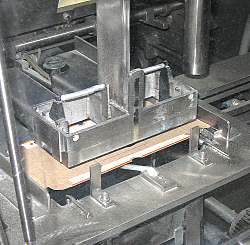LAUGHTON ELECTRONICS |
|||
Boxes on demand: machine control via CMOS logic |
|||
| This article describes
modifications to
existing factory equipment. A related control device to help
minimize
work stoppages. |
|||
|
A printing operation was upgrading their assembly line, and they had purchased a machine they wanted to dovetail into the existing setup. The new machine was a boxmaker that folded and glued light cardboard cartons used to ship the product. The customer wanted the boxmaker to cycle on and off so as to keep pace with the bindery machine that finishes the product. Neither machine had been built with this sort of operation in mind. In order to accomplish
this, I had to focus mainly on the boxmaker, which happened to use
pneumatic
rather than electrical switches and controls. But the job was fairly
straightforward after I installed a small DC power supply and hooked an
air solenoid into the pneumatic plumbing. I was rewarded with the
sight of the US-made boxmaker operating in sync with the German-built
bookbinding machine. Preventing lost time due to jam-upsPhase two of the project was an unanticipated post-script. The boxmaker had one shortcoming, and that was a very unpleasant "snowball effect" if ever a jam-up occurred. For the operator to clear a single-box jam was easy... but if a second box got jammed on top of the first it made a terrible mess! For that reason there was a strong incentive to have the boxmaker shut down promptly following the initial jam. I assembled a jam-up detector based on a run-of-the-mill 24V photosensor that detected boxes on the chute exiting the boxmaker. Meanwhile, a couple of one-shot timers tracked the machine's start delay and cycle time, thus determining when a box ought to appear. If the photocell failed to see a box by the time one was due to appear, a flip-flop would latch, stopping the machine and illuminating an alarm signal. The circuit only used a few CMOS logic chips and was able to take its power from the little PSU for the air solenoid. (Nowadays I'd use an inexpensive PLC for a job this.) |
||
|
|||
 |
|||
